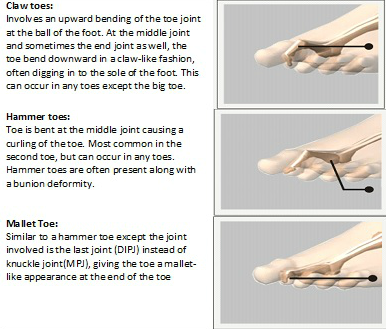What are Hammer / Claw / Mallet Toes?
Hammer/ Claw/ Mallet Toes are all variations that can happen to the small toes. They are slightly different in joint involvements.
The main problem with deformed toes is that they tend to rub on shoes and this may simply be uncomfortable or the skin may be rubbed raw and this may result in ulcers. Bent toes may also rub on one another or on the big toe if there is a concurrent bunion deformity.
If the MTP joint is bent upwards, the toe may press down and cause pain in the ball of the foot (“Metatarsalgia”).
What causes Small Toe Deformities?
- Poorly fitting shoes: usually wearing shoes that are too short
- High Arched foot
- Genetics
- Bunions
- Rheumatoid arthritis
- An underlying neurological condition such as Charcot-Marie Tooth (CMT) disease
- Diabetes
- Tendon imbalance

Conservative Treatments
- Putting padding between your toes and strapping them in place may help to stop pain caused by toes rubbing.
- Orthoses can reduce excessive pressure from painful areas.
- Shoes with wider and deeper toe areas can also help you get around more easily.
- A regular visit to podiatrists to remove painful hard skin can help reduce pain in the short term.
If these measures do not work, surgery may be an option.
Surgical Treatments
Do I need surgery?
In most mild cases, conservative treatments such as orthoses, shoe and activity modifications can relieve pain and discomfort. Surgery is recommended if these conservative treatments have failed to improve symptoms.
What does the surgery involve?
The surgery for small toe deformities is usually a day-case procedure and takes around 30 minutes. The surgery depends on the problems but typically following procedures are involved in the surgery:
- Releasing or lengthening tendons
- Putting joints back into place
- Straightening a toe by removing some bone
- Stiffening one of the toe joints
- Changing the shape of metatarsal bone to shorten or lift it away from the skin in the ball of the foot
- Anaesthetics: Various anaesthetics are available (General or spinal block or local anaesthetics with sedation)
After the Surgery
- Keep your foot elevated as much as possible and apply an ice pack for the first week following surgery
- Your dressing will be changed between 3-7 days at the office after surgery
- Keep your dressing dry for the first 2 weeks after surgery
- Sutures will be removed between 2-3 weeks after surgery
- You are able to weight-bear on the heel in the postop surgical shoes
- You need expect to wear post-op surgical shoes for 2-4 weeks


